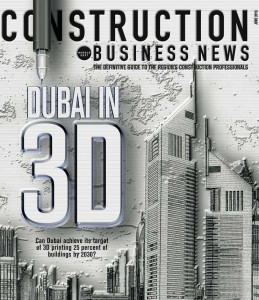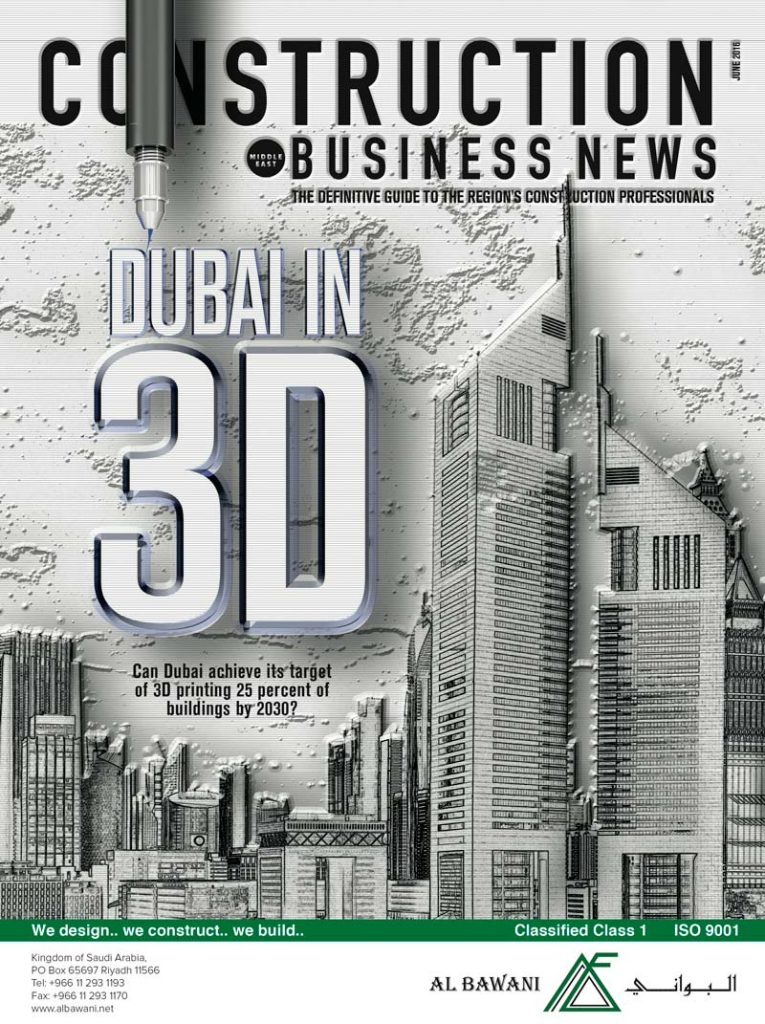Can the emirate achieve its goal of producing 25 percent of buildings using 3D printing technology by 2030? Jason O’Connell writes.
His Highness Sheikh Mohammed bin Rashid Al Maktoum is nothing if not a man of vision. And he sees the future of Dubai very clearly: In 3D.
Last month the Vice-President and Prime Minister of the UAE and Ruler of Dubai launched the world’s first fully functional 3D printed office building on the premises of Emirates Towers. The 250 m2 building, which will house the temporary office of the Dubai Future Foundation, took only 17 days to print using a special mixture of cement deployed by a 3D-printer measuring 20 ft high, 120 ft long and 40 ft wide.
If Sheikh Mohammed has his way it will be just the start of a revolution in how buildings are made in the emirate and beyond. The office building was unveiled less than a month after Dubai launched its 3D printing strategy, an ambitious initiative aimed at producing 25 percent of buildings using 3D printing technology by 2030. Medical and consumer products are the other two sectors targeted under the strategy.
Sheikh Mohammed pointed out that 3D printing has the potential to offer competitive advantages in terms of lower costs and faster delivery. It could help reduce manpower requirements and cut back on waste generated from construction.
“Through the 3D Printing Strategy, we aim to make Dubai a global hub for the development of this technology and a base for research and development in this area,” Sheikh Mohammed said. “We aim to provide the best opportunities for innovation and optimal application of this technology worldwide. Our goal is to raise the level of services provided to the people and harness 3D printing for the benefit of the entire community.”
The value of the 3D printing technology-based construction sector in Dubai is expected to reach around AED3bn ($816mn) by 2025, providing huge opportunities for companies involved in the sector. Globally the market is expected to reach $120bn by 2020 and about $300bn by 2025, as research and development accelerates the capability and cuts the cost of the technology.
As usual Dubai has wasted no time in putting its words into actions. Within a week of the strategy being announced, Dubai Holding launched plans for the International Centre for 3D Printing at Dubai Industrial City, which aims to house 700 companies under one roof. The facility will bring a network of design and technology suppliers and include research facilities and laboratories for testing materials used in 3D printed products. It will also offer services, professional training, facilities, storage solutions, and other logistical support to strengthen this sector.
Abdullah Belhoul, CEO of Dubai Industrial City, said: “The centre will offer the advantages of strategic location, advanced infrastructure, developed offices, warehouses, exhibition facilities, not to mention the integrated support system that will enable companies to establish their business. The centre will host more than 700 local and international companies to make Dubai a major hub of 3D printing technology.”
Dubai Electricity and Water Authority (DEWA) has also backed the new strategy with a contract tender for a building using 3D printing technology. The utility wants to add a laboratory at its solar park that will conduct research into both 3D printing and drone technology which it uses to help monitor and maintain its various facilities.
So Dubai certainly has the ambition. But can it turn those dreams into reality? Naji Atallah – Head of AEC and Manufacturing at Autodesk Middle East and Turkey – certainly thinks so. Autodesk Middle East hosted the inaugural Future of Building Things event in Dubai last month, a forum for industry professionals to discuss how technology is disrupting the way buildings and infrastructure are designed, built and used. It was fitting that the event took place in the Annex of Burj Khalifa, surely one of the most advanced buildings ever made. Unsurprisingly, 3D printing was a very hot topic at the forum coming just a few weeks after Sheikh Mohammed’s announcement.
“It’s a very ambitious objective and with today’s technology it’s definitely not achievable,” says Atallah of Dubai’s 3D Printing Strategy. “But I think part of what HH Sheikh Mohammed has done is set a framework for the construction and 3D printing communities to work with to reach an objective. At Autodesk we think it is achievable. How the construction site in 2030 will look like is not that clear yet but we’re contributing to realising that vision.”
While 3D printing has yet to make major inroads into the mainstream construction sector, Atallah points to a couple of “pockets of innovation” that provide an indicator of what might become the norm within a few years. One example is a company called MX3D which is working on 3D printing a metal pedestrian bridge over a canal in Amsterdam.
“The device they created is not a 3D printer in the traditional desktop sense, it’s actually two robotic arms with a nozzle at the end that deposits the material layer by layer,” Atallah says. “You start with a 3D model and the software slices the model into very thin wafers and the nozzle deposits the material to create these layers one at a time. In this case the nozzle deposits softened metal, building the bridge as it goes.”
The other example he points to comes from China, where a company called Winsun gained Youtube notoriety when it 3D printed 10 low cost housing units in a single day using their own cement mixture. Winsun used Autocad, an Autodesk software, to control the movement of the nozzle and how it deposited the layers of cement.
Disruptive, was a word that kept cropping up at The Future of Building Things conference in reference to new technologies that have the potential to radically alter the way the construction industry works, with consequences for all stakeholders, from architects to designers, suppliers, contractors and workers.
“It’s not one party that gets disrupted [by the technology], I think the way the entire industry works gets disrupted,” says Atallah. “A major challenge in the industry now is wastage. If you’re building a tower you’re cutting and wasting material and that’s a major cost for the industry. 3D printing has the potential to really reduce that wastage thus decreasing the whole cost of building an asset, which would have implications for everyone involved in the project.”
Like all relatively new technologies there are still issues with the cost of 3D printing but Atallah says the cost has dropped considerably to the point where you can buy a desktop 3D printer for as little as $1,500 whereas 10 years ago they didn’t even exist.
“The process is much faster and the most interesting part is that you can mount 3D print in different materials,” he says. “So whereas it used to be just a few kinds of plastics, now you can do it in ceramics, metals even carbon fibre. Whatever the application is, one of these materials will fit. The widespread requirements across industries has helped drive the cost of the hardware down.”
With Dubai looking to use the technology to produce 25 percent of any given building by 2030, which particular components or materials might be particularly suited to 3D printing? Atallah cites the panels used in façade cladding as potentially ideal for 3D printing because it enables you to print exactly the size you need instead of cutting it onsite which wastes materials. “With today’s architecture, each panel in the façade of the building is unique and it’s this uniqueness that makes it more applicable to the 3D printing way of doing things,” he says.
But he says the sky is the limit as far as what 3D printing could produce in the future. “We will find some components printed off site and some will be printed on site. What the components are is completely open. We could even be printing glass. And for example with the bridge it’s the structural part, the metal, that is being 3D printed so I wouldn’t be surprised that by 2030 you have huge metal girders being printed.”
A Technology of the Future
The consensus of a five man discussion panel at The Future of Building Things, was that it is likely to be a long time before 3D printing exerts a truly disruptive force on the construction industry due to a number of factors, particularly the cost of the technology. Sean McQue – Projects Director for UAE at construction contractor ALEC – stressed that the market will always dictate the methods used for construction.
“Construction is one of those industries that fundamentally hasn’t changed for a long, long time,” he said. “We see innovation in design and technology but when it gets onto the ground that’s where you struggle to realise change. As long as it’s cheaper to build things with labour, it’s going to happen that way. If clients and designers start to drive things from the front and specify that’s what they want to see, then you’ll start to see it coming because it is going to initially be a much more expensive process.”
Sean Dewhurst – Change and IT Director at SSH – believes it will be a gradual process to reach a stage where anyone is using 3D technology to print a tower building because of the uncertainty inherent in using newly developed methods. “No one is going to want to build a 3D printed office tower and be the first person to do it. It introduces a lot of risk and at the end of the day multi-million dollar projects are not where you want to be sinking a lot of risk. There has got to be experimentation on a small scale and then confidence built up.”
Geoff Batzel – Chief Strategy and Implementation Officer at KEO International Consultants – said he would not be pushing the technology on clients any time soon. “We saw recently in Dubai the news about the world’s first 3D printed office centre. Ok, that’s a special one off and that will slowly start to trickle down, but honestly as a consultant engineer you’re probably not going to try to push the envelope on your clients, it’s just not a good business model.”
Andy Shaw –Associate Director at architecture firm RMJM International in Dubai – said 3D printing had already afforded him opportunities to innovate on a small scale. “One thing I’m working on at the moment is looking at 3D printing cladding and fusing that with casting technology for mass production and to make it more cost effective,” he said.
“Having a plan isn’t always the best way. When you innovate you have to experiment and not actually know where you’re going to end up. The key is to start small. They’ve started with the office here. Construction of a villa or a smaller outbuilding or a temporary office is a much more feasible target at the moment. Keep learning and scaling up. It’s going to be a long time until anybody is 3D printing a whole tower, but if you start small you can start learning and get the cost down.”
Suhail Arfath – Head of Consulting at Autodesk Middle East, Turkey and Africa – stressed that Dubai’s 3D printing strategy was an important step in helping to drive the technology forward. “Two things are going to drive innovation around 3D printing,” he said. “One, we have got this mandate now by 2030. We have a goalpost there so we know where we’re headed. At the same time construction is predominantly a low margin industry. As we see the cost of materials for 3D printing going down it’s going to really be seen more and more in construction.”

